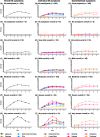Patient factors influencing acute gluten reactions and cytokine release in treated coeliac disease
- PMID: 33239013
- PMCID: PMC7690153
- DOI: 10.1186/s12916-020-01828-y
Patient factors influencing acute gluten reactions and cytokine release in treated coeliac disease
Abstract
Background: Patients with coeliac disease (CD) commonly report a variety of adverse symptoms to gluten, but descriptions of the symptomatic response in the literature may have been confounded by the presence of food components such as fermentable carbohydrates (FODMAPs) causing symptoms of irritable bowel syndrome independent of gluten. In recent unmasked and masked low FODMAP gluten challenge studies in small groups of treated CD patients, nausea and vomiting were shown to be the key symptoms associated with serum interleukin (IL)-2 release. Our objective was to utilise a large and diverse cohort of people with CD undertaking a standardised gluten food challenge to characterise the demographic, genetic and clinical factors influencing the severity and timing of acute gluten reactions and IL-2 production.
Methods: A total of 295 adults treated for CD were observed for 6 h after an unmasked food challenge consisting of 10 g vital wheat gluten (low in FODMAPs) in 100 ml water. Assessments included patient-reported outcomes, serum IL-2 and adverse events. Responses were analysed according to patient characteristics, HLA-DQ genotype, duodenal histology and response to a second gluten challenge.
Results: Peak symptom severity was at 3 h (median severity 5/10). Peak IL-2 was at 4 h (median 4 pg/ml, range undetectable to 1028 pg/ml). Older age, older age at diagnosis, HLA-DQ2.5 positivity and homozygosity for HLA-DQB1*02 were each significantly associated with IL-2 elevations after gluten. Patients positive for HLA-DQ2.5, DQ8, DQ2.2 or DQ7 showed elevated IL-2 after gluten. Patient factors were not significantly associated with severity of digestive symptoms, but symptoms were correlated to one another and serum IL-2. Gluten challenge after 5 months caused more vomiting and higher IL-2 levels, but responses correlated with the first.
Conclusions: Gluten-induced symptoms and cytokine release is common in adults with treated CD. Age, genetics and previous response to gluten predict these acute reactions to gluten challenge. Structured symptom assessment and serum IL-2 after standardised gluten challenge may inform on patient diagnosis, the role of gluten in symptomatology and the need for adjunctive treatment.
Trial registration: ClinicalTrials.gov , NCT03644069 Registered 21 May 2018.
Keywords: Coeliac disease; Cytokine; Food challenge; Gluten; Patient-reported outcome.
Conflict of interest statement
GG, KEG, HLH, KMN, KET, LJW and RPA were former employees of ImmusanT, Inc. JAT-D and AJMD served as advisors to ImmusanT, Inc. RPA is the inventor of patents, owned or licenced by ImmusanT, Inc., relating to the diagnostic application of gluten challenge.
Figures



References
-
- Skodje GI, Sarna VK, Minelle IH, Rolfsen KL, Muir JG, Gibson PR, Veierod MB, Henriksen C, Lundin KEA. Fructan, rather than gluten, induces symptoms in patients with self-reported non-celiac gluten sensitivity. Gastroenterology. 2018;154(3):529–539. - PubMed
-
- Colloca L, Barsky AJ. Placebo and nocebo effects. N Engl J Med. 2020;382(6):554–561. - PubMed
Publication types
MeSH terms
Substances
Associated data
LinkOut - more resources
Full Text Sources
Medical
Research Materials

